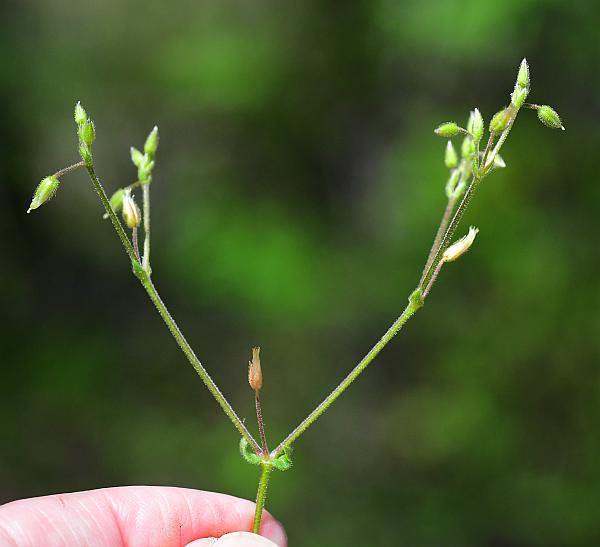Cerastium pumilum Curtis
Curtis's Mouse-eared Chickweed

Introduced
CC = *
CW = 5
MOC = 29
© SRTurner
Cerastium pumilum CurtisCurtis's Mouse-eared Chickweed | |
 |
Introduced CC = * CW = 5 MOC = 29 |
© SRTurner |
|
Family - Caryophyllaceae Habit - Annual forb. Stem - Ascending to erect, 4-20 cm long, unbranched or branched toward the tip, densely pubescent with short glandular and nonglandular hairs.
Leaves - Opposite, simple, sessile. Blades 0.3-2.0 cm long, spatulate (especially toward the stem base) or oblong to ovate, fused at the base into a sheath, angled to a pointed tip, densely hairy on both surfaces.
Inflorescences - Open panicles. Flower stalks 0.3-0.6 cm long, 1.0-1.5 times as long as the sepals, erect or ascending at flowering and fruiting, densely pubescent with short glandular hairs, the bracts green, the upper bracts with narrow, thin, white to translucent margins.
Flowers - Sepals 5, 3-5 mm long, lanceolate, angled to a sharply pointed tip, green or sometimes reddish-tinged toward the tip, densely pubescent with short glandular hairs, these not extending past the sepal tips, usually with wide translucent margins. Petals 5, 3-5 mm long, about as long as or slightly longer than the sepals, notched or shallowly lobed at the tip, the veins branched. Stamens mostly 5. Styles 5.
Fruits - Capsules 4.0-7.5 mm long, 1-2 times as long as the sepals, straight or slightly curved. Seeds 0.6-0.7 mm wide, the surface with bluntly to sharply pointed tubercles, brown.
Flowering - April - May. Habitat - Glades, pond margins, tops of bluffs, pastures, fields, lawns, railroads, roadsides, and open, disturbed areas. Origin - Eurasia. Lookalikes - Several other species of Cerastium. Other info. - This small, inconspicuous species is one of several Missouri members of the Cerastium genus. Most people, and more than a few botanists, would collectively label them "weeds" and pay no further attention. Collections of this species in Missouri are concentrated in the southern half of the state. Beyond Missouri it is found in scattered locations throughout the eastern half of the continental U.S., and also in the Northwest. It is likely more prevalent than collections suggest. The plant is easily recognized as a Cerastium by general appearance, with small white flowers and distinctive tubular fruits having toothed tips. Identification to species is more difficult and requires close attention to tiny details. In particular, this species has inflorescences which are densely glandular but not conspicuously hairy, upper inflorescence bracts having membranous margins (see photo above), and petals which are small (similar to sepals in size). The fruits are somewhat longer than the sepals, and the inflorescences relatively open and not crowded. There are usually five stamens. Photographs taken at St. Joe State Park, St. Francois County, MO, 4-26-2020; Canaan Conservation Area, Gasconade County, MO, 4-26-2021; and Shaw Nature Reserve, Franklin County, MO, 4-24-2023 (SRTurner). |